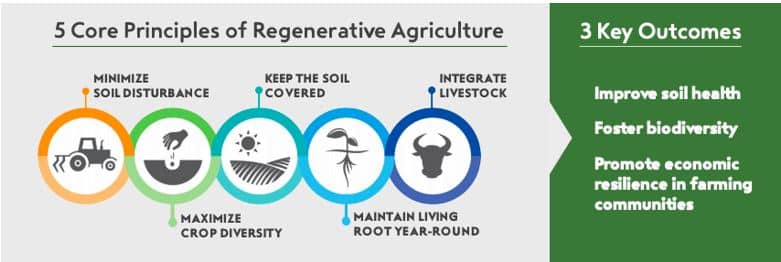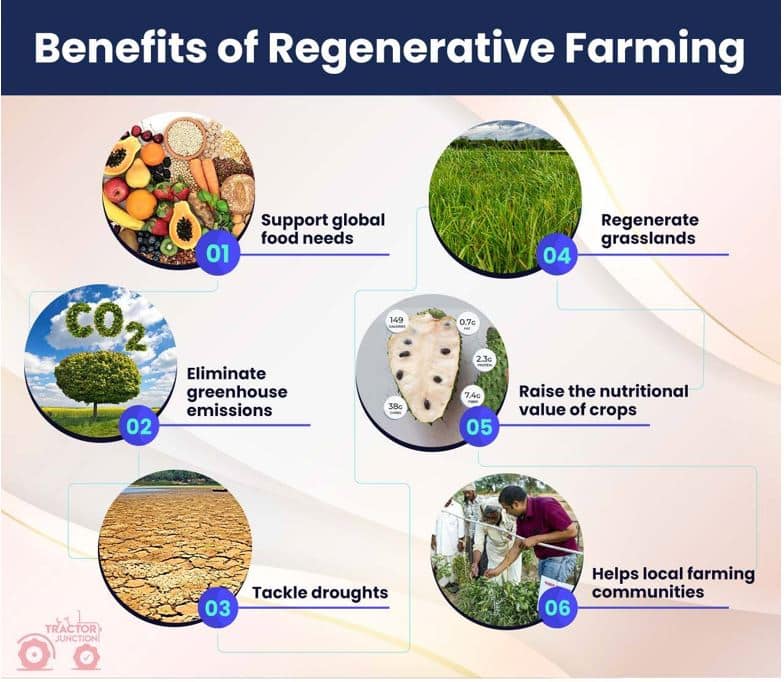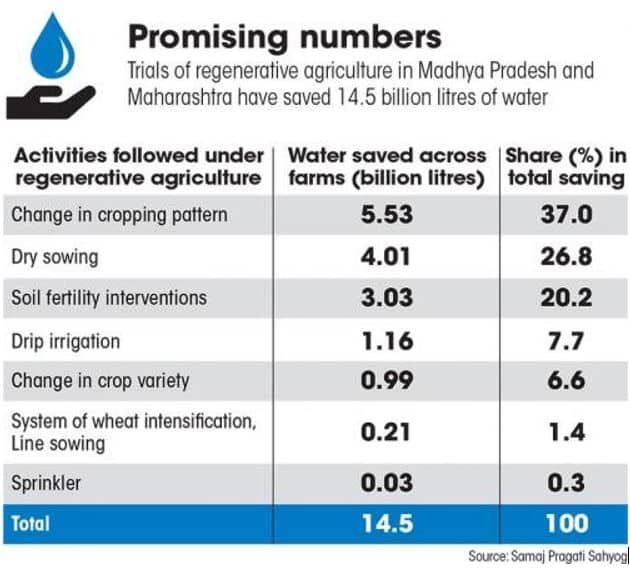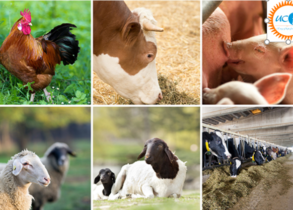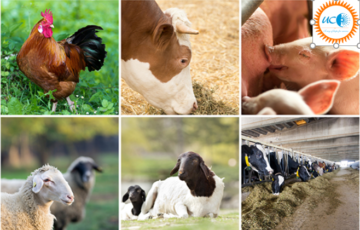Regenerative agriculture: A step towards water conservation
Context: Farmers, activists and agricultural research organisations across the world are developing methods of regenerative agriculture, going a step ahead of sustainable agriculture, not only to maintain the resources like soil and water but also to improve them.
Background:
- India was saved from starvation during the Green Revolution in the 1960s, and as a result, it became a significant food exporting nation in addition to being self-sufficient.
- However, the revolution also made India the largest groundwater extractor in the world.
- The nation collects 251 cubic kilometres of groundwater annually, or more than a quarter of the world’s total, and 90% of this is used for agriculture, according to the UN’s World Water Development Report, 2022.
- If agriculture is to continue providing food for the undernourished population of the nation and powering the economy, it must work in harmony with nature rather than against it.
- Regenerative agriculture is being promoted in India by the Union and state governments (UK, HP, Andhra Pradesh, Sikkim, and Gujarat) in an effort to reduce the use of chemical fertilisers and pesticides and to lower input prices.
The regenerative agriculture:
About:
- It is a set of farming ideas and practises that prioritises soil health while also paying attention to other factors like water management and fertiliser use in order to restore and improve the farm’s complete ecosystem.
- It is a farming technique where the focus is on taking a holistic approach to the agro-ecosystem and enhancing the resources it utilises rather than destroying or depleting them.
Key techniques include:
Types of Regenerative Agriculture:
1.No-Till and pasture cropping
This type of regenerative farming/agriculture says, “disturb no soil”. In this type of farming, special drillers are used to seed the cultivation plants. And, the grass here is left for grazing to animals or livestock. This helps in preventing soil erosion as well.
2.Annual Organic Cropping
Organic cropping, as we all know, is the use of organic means for crop cultivation. This type of farming is less expensive, more time-consuming and requires an equivalent amount of labouring efforts in India. But, people practice the inorganic method more because of its availability. However, this type of farming is becoming more and more trending due to consciousness among people.
3.Compost tea and compost
Compost tea increases soil fertility and improves micro-organic growth in the soil. Hence, obtaining the primary goal of regenerative agriculture. The optimal concentration of organic matter in the topsoil (almost 6 inches of it) should be 3-5%. And, hence the name.
4.Biochar and Terra Preta
In this type of regenerative agriculture, we use black carbon as the source for maintaining soil health and microbial biodiversity. Black carbon is very effective in increasing soil fertility. Research shows that black carbon can increase the fertility of the soil by more than 70 times.
5.Perennial cropping
This type of regenerative agriculture deals with potential soil erosion areas by not weeding out the soil. This saves farming costs and reduces tilling operations. The strong roots of grasses save the soil from erosion during worse economic conditions.
6.Ecological Aquaculture
In this regenerative farming, the aquatic life is protected and inhabited by nurturing them with trees and organic matter. This promotes healthy aquatic life in and around farmlands. Thus, a sustainable food chain is maintained.
Regenerative Farming Benefits:
Regenerative agriculture has not only brought sustainability but also paved the way for cleaner and greener earth with less carbonic emissions. In this discussion, let us ponder about some specific points of why is it of utmost importance:
1.Support Global Food Needs
The earth’s population is continuously growing. And hence the demand for food and related resources has also increased. Surveys show that smaller-scale farms are more than large-scale farms. So, small-scale farms supply most of the food in the world.
2.Eliminate GreenHouse Emissions
Regenerative agriculture might seem a little bit of a conventional term. As it helps restore the environment and avoid carbon emissions from the surface to the earth’s atmosphere.
3.Tackle Droughts
Regenerative agriculture is tackling droughts by restoring soil moisture, microbial life and carbon. It improves water retention and filtration.
4.Regenerate Grasslands
70% of Earth’s grassland has vanished due to modern agriculture techniques. Thus regenerative farming helps restore the earth’s carbon absorbers into its soil.
5.Raise the Nutritional Value of Crops
More is the biodiversity of the soil, the more its nutritional value. Hence, regenerative farming is necessary.
6.Helps Local Farming Communities
It helps local farming communities by helping them with employment opportunities.
The Difference Between Regenerative Agriculture and Organic Farming
| S.No. | Regenerative agriculture | Organic Farming |
| 1. | It is the practice of restoring soil health and the ecosystem around it. | This branch of farming only helps you restore the soil. |
| 2. | It solves almost every food problem the earth is facing or going to face in the future. | It solves only the problem of soil degradation. |
Efforts in India to promote regenerative agriculture:
- The National Organic Farming Project
- Systematic rice intensification is a technique that increases yields by spacing seeds farther apart and using organic manure.
- Subhash Palekar Natural Farming, which focuses on zero-budget natural farming, emphasises the preparation and use of inputs made from fruit, cow dung, and urine, among other things.
Challenges: There are no structured studies available on the water-saving potential of regenerative agriculture.
Way ahead:
- Scientific organisations are best suited to carry out these tests and computations because farmers and civil society organisations lack the resources to do so.
- Such studies will significantly advance regenerative agriculture.
Mains :
- How and to what extent would micro-irrigation help in solving India’s water crisis? (UPSC 2021)
Prelims Links: (UPSC 2018)
With reference to organic farming in India, consider the following statements:
- The National Programme for Organic Production’ (NPOP) is operated under the guidelines and directions of the Union Ministry of Rural Development.
- The Agricultural and Processed Food Products Export Development Authority’ (APEDA) functions as the Secretariat for the implementation of NPOP.
- Sikkim has become India’s first fully organic State.
Which of the statements given above is/are correct?
- 1 and 2 only
- 2 and 3 only
- 3 only
- 1, 2 and 3
Ans: 2

